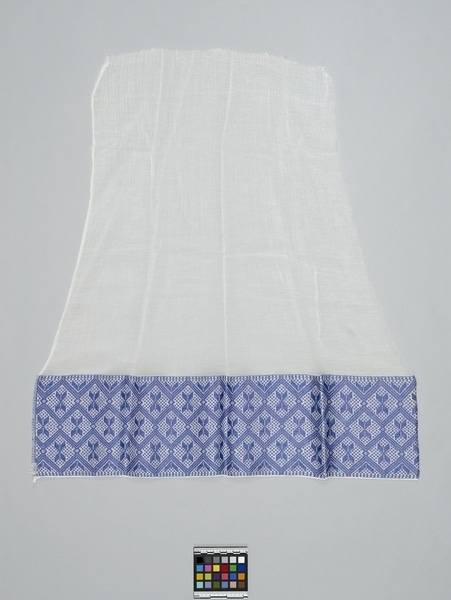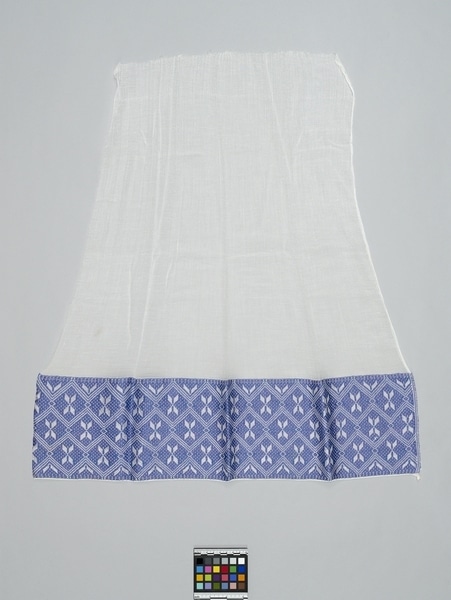Scarf Item Number: Ca37 from the MOA: University of British Columbia


Description
A very fine sheer white textile with a geometric design at one end. The main design is consisting of blue and purple diamond shapes with four elongated white diamond shapes radiating from a central point within.
History Of Use
Netela scarf, or shawl, for wrapping around the upper body. The cloth is traditionally woven by men, but mostly worn by women. The weaving techniques and embroidery used in Ethiopian textiles such as shemma are reminiscent of very early cultural exchange and trade between Ethiopian society and their neighbours. Like other Ethiopian shawls, it has historically been woven on a horizontal pit loom, usually by two male weavers at once. White cotton with embroidered bands is generally associated today with cultures in the north of Ethiopia. The colourful weft borders are known as tibeb; they often involve geometric patterns and cross motifs. The predominant colour of such embroidery tends to be green, but yellow, red and blue and even gold thread are also popular. Although the main market for purchasing handwoven cotton clothing is in the northern regions, many handwoven cloths like this are woven by groups in the south, for sale in the north (Gillow, 2009). The weft border on this cloth is blue, indicating that it was likely worn by Amhara peoples, who favour this design (Chane, 2019).
Specific Techniques
Made on a man's loom which is confined to widths of 4-6 inches. These looms are light and portable which allows men to weave in groups. Men weave professionally and form guilds. Women use vertical stationary looms and weave at home.
Item History
- Made in Ethiopia before 1974
- Collected during 1974
- Owned by Lemma Admasu before December 27, 1979
- Received from Lemma Admasu (Seller) and Museum of Anthropology Donations Fund (Funding source) on December 27, 1979
What
- Name
- Scarf
- Identification Number
- Ca37
- Type of Item
- scarf
- Material
- cotton fibre and dye
- Manufacturing Technique
- woven and sewn
- Overall
- height 66.5 cm, width 62.0 cm
Who
- Culture
- Amhara
- Previous Owner
- Lemma Admasu
- Received from
- Lemma Admasu (Seller) and Museum of Anthropology Donations Fund (Funding source)
Where
- Holding Institution
- MOA: University of British Columbia
- Made in
- Ethiopia
When
- Creation Date
- before 1974
- Collection Date
- during 1974
- Ownership Date
- before December 27, 1979
- Acquisition Date
- on December 27, 1979
Other
- Item Classes
- textiles
- Condition
- good
- Accession Number
- 0587/0003